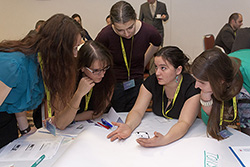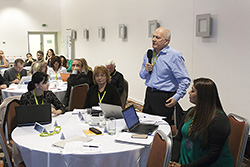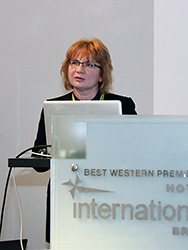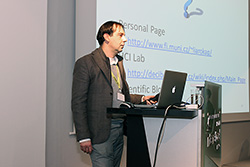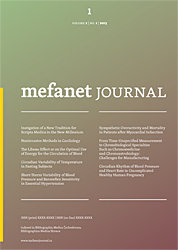
MEFANET Journal 2016; 4(1): 50–54
EDITORIAL MATERIAL
MEFANET 2015: new format of a traditional conference
Martin Komenda*, Daniel Schwarz, Jakub Gregor, Lenka Šnajdrová
Institute of Biostatistics and Analyses, Faculty of Medicine, Masaryk University, Czech Republic
* Corresponding author: komenda@iba.muni.cz
Abstract
Article history:
Received 6 January 2016
Available online 6 April 2016
Download PDF
Supplementary material
The ninth year of the MEFANET conference saw several organisational changes, which might have been perceived either as a facelift by some people, or even as a new model by others. What remained, however, was the desire to share one’s own experience with modern approaches and technologies in the education of medical and health care disciplines, and to get new information and ideas from others.
Keywords
MEFANET; medical informatics; e-learning; virtual patient; e-assessment
Again, the MEFANET conference was held in late November in Hotel International Brno, Czech Republic. In 2015, however, the organisers decided to do things differently. In particular, more attention was paid to practical workshops, which took place in the afternoon of the first conference day. Unconventionally, the invited lectures and plenary sections with contributions of authors from across Czech and Slovak medical faculties took place on the second conference day.
The event started with a quick Wednesday’s lunch, attended by participants of the first workshop and by the team of Petr Stourac, MD, PhD, head of the Department of Paediatric Anaesthesiology and Resuscitation, who guaranteed the entire section. The conference programme started with their workshop dedicated to interactive algorithms in the education of emergency medicine, which have been developed for many years now by this team within the AKUTNĚ.CZ® project. Divided into groups and led by expert instructors, workshop participants tried to create plausible clinical scenarios, which might possibly be later used in the education of physicians as well as non-physician health care professionals. After finishing their work, the participants presented both the basic structure of their scenario and “dead ends” in the form of unnecessary examinations or even patient harm, which might be intentionally set up to test the students’ knowledge. Workshop guarantors were satisfied both with the variety of topics and with their contents.
The second practically oriented workshop was primarily aimed at participants of the CROESUS projects, in which three universities (Masaryk University, Pavol Jozef Safarik University in Kosice, and St George’s, University of London) are involved. However, other conference participants, who were interested in virtual patients, were very welcome as well. A theoretical introduction was followed by presentations by clinicians of different specialties, who were trained within the CROESUS project in the development of branched virtual patients and in the application of these patients in problem-based learning (PBL) sessions; the presentations involved drafts of virtual cases as well as examples of their implementation based on the OpenLabyrinth platform. Dr Andrea Pokorna from the Faculty of Medicine at Masaryk University then commented on their presentations, providing a valuable feedback for authors. Dr Pokorna emphasised that virtual cases should be interactive and should not contain excessive amount of information in the form of texts, which might actually distract the user’s attention from solving the case. In the end, guests from the London team of Prof Terry Poulton also summed up their overall impression of the workshop.
For that matter, Dr Ella Iskrenko-Poulton was one member of this team, and also gave the first invited lecture entitled “Scenario-based learning: what can it provide now for the learner, and how can we use it next?” In her teacher-oriented lecture, Dr Iskrenko-Poulton introduced various forms and uses of interactive and simulative methods of education that fall within the definition of “scenario-based learning”. Real clinical scenarios, whether it be in the form of interactive computer simulations, games, virtual worlds or dummies, are undoubtedly an excellent means of teaching and practising the ability to decide, to cooperate, and to avoid potential mistakes in future clinical practice. Dr Iskrenko-Poulton also mentioned the recently emerged type of electronic courses called the Massive Open Online Courses (MOOC), which led to a heated debate with the audience.
The second invited speaker, Fotios Liarokapis, PhD, from the Faculty of Informatics at Masaryk University, had a more technology-oriented lecture. Dr Liarokapis mentioned not only virtual and augmented reality, but also the communication between the human brain and computer via various interfaces. Additionally, he demonstrated how this technology might be used in interactive applications to simulate a real environment, not only in the education of medicine. During his lecture, he gave the audience a tour of the site of a recent bomb explosion in London (which only happened virtually, of course!) or of the centre of ancient Rome. Many of these applications can nowadays be controlled by EEG waves via a brain-computer interface (BCI), without using any mouse or keyboard; the user can thus fully immerse himself/herself in the “game” and task solving. Dr Liarokapis also presented results of studies demonstrating that as regards control by EEG waves, there were differences between users who were passionate and experienced players of computer games, and beginner players.
Like in the previous years, one section of the MEFANET conference was dedicated to the application of modern technology in the education of a specific branch of medicine: this year, it was neuroscience, which added a new dimension to an already attractive topic. At the beginning of this section, representatives of the Faculty of Medicine in Plzen invited the audience to visit a virtual restaurant that aims to help with the treatment of alcohol abuse. After all, it would not go amiss even for moderate drinkers to have occasional training of turning down invitations to get a drink... Other contributions shifted the topic as far as into the area of psychiatry; lectures accompanied with popular video streaming from operating theatres of neurosurgery departments were also involved.
The MEFANET conference also hosted two working meetings related to international projects of the Erasmus+ programme, which is currently the EU flagship in the area of education support. Namely, these were the TAME (Training Against Medical Error) and MEDCIN (Medical Curriculum Innovations) projects, which brought representatives of individual partner universities from Sweden, the United Kingdom, Greece, Kazakhstan, Malaysia and other countries to Brno. Masaryk University represents the MEFANET network in both projects, and has made a continuous effort to deepen mutual cooperation with foreign institutions and to implement globally respected trends, methodology and technology into Czech conditions.
The ninth year of the MEFANET conference brought varied and very inspiring contents again. The new model, combining working meetings with lecture sessions, attracted more than a hundred of participants, who together created a congenial and relaxed atmosphere. The organisers believe that the tenth anniversary conference, which will traditionally be held in Brno in late November (29–30 November 2016), will be at least as successful as the last one.
Supplementary material
Please cite as:
Komenda M, Schwarz D, Gregor J, Šnajdrová L. MEFANET 2015: new format of a traditional conference. MEFANET Journal 2016; 4(1): 50-54. Available at WWW: http://mj.mefanet.cz/mj-20160106.
This is an open-access article distributed under the terms of the Creative Commons Attribution-NonCommercial-ShareAlike 3.0 License (http://creativecommons.org/licenses/by-nc-sa/3.0/), which permits unrestricted use, distribution, and reproduction in any medium, provided the original work, first published in the MEFANET Journal, is properly cited. The complete bibliographic information, a link to the original publication on http://www.mj.mefanet.cz/, as well as this copyright and license information must be included.
